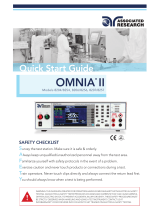Page is loading ...

LINE POWER
TEST STATUS
READY TESTING FAIL
DANGER
START
RESET A
B
CHASSIS
GROUND SENSE
GROUND CONTINUITY TESTER
GROUND TEST CURRENT GROUND RESISTANCE
HIGH
VOLTAGE
DURING
TEST
GND/HIPOT
GND
QUICK START GUIDE
Phone:
(650) 322-0711 • (800) 548-6305
Fax: (650) 326-1993
Online: info@rodl.com • www.rodl.com
FOR MODELS:
M25
M30
M35
M40

1
LINE POWER
TEST STATUS
READY TESTING FAIL
DANGER
START
RESET A
B
CHASSIS
GROUND SENSE
GROUND CONTINUITY TESTER
GROUND TEST CURRENT GROUND RESISTANCE
HIGH
VOLTAGE
DURING
TEST
GND/HIPOT
GND
Ground Sense Wire Power Cord
metal part of handle
Device Under
Test (DUT)
DUT with 3 Prong Plug
WHAT IS NEEDED FOR FOR SELF TEST AND BASIC DEVICE TESTING:
(The ground sense wire has a large
banana plug which inserts into the
“Chassis Ground Sense post on the
front panel of the ROD-L unit and large
allegator clip to be connected
to the DUT)
(The power cord connects to the rear
panel of the ROD-L unit and to any
grounded three-prong wall socket. Be
sure to set the line voltage on rear panel
to correct voltage i.e. 110 or 220)
1.a Make sure the line voltage
switch on rear panel is set to
the correct value for the wall
outlet (i.e. 110 or 220).
1.bConnect the POWER CORD
to the rear of the ROD-L
Unit and plug into any three-
prong grounded wall outlet.
1.c Turn on the Line Power on
the front panel of the ROD-L
Unit. Green ready light
should light.
1.d Insert banana end of
GROUND SENSE WIRE into
the Chassis Ground Sense
post on the front panel of
ROD-L unit.
1.e Connect allegator clip of
ground sense wire to the
metal portion of the ROD-L
unit handle.
1.f The GND-HIPOT/GND
switch should be in the
“GND” position unless the
unit is being interfaced with a
hipot tester.
1.g Press “Start.”
After you press start, the “Testing” light will light for a brief period of time and then shut off.
This completes the self test.
Disconnecting the Ground Sense Wire from the Chassis Ground Sense post or the metal part of handle will cause
the test to fail. The red fail light will light, the audible alarm will sound and the unit will shut down. If this happens,
press the Reset button to turn off the alarm.
2. BASIC DEVICE TEST
1. SELF TEST
Make sure your test parameters are set correctly on the rear panel. If you are unsure or need to set any test
parameters, see instructions on the next page or refer to the manual.
2.a Plug the three-prong plug of the DUT into the front
panel receptacle of the ROD-L tester 2.b Connect the allegator clip of the Ground Sense
Wire to the DUT.
2.c Press “Start.” Testing light will light for a brief
period of time and then return to ready mode if
test passes. 2.d If failure light and audible alarm turn on,
disconnect the DUT and press the Reset button
on tester to cancel alarm.

2
TOTAL OHMS
TRIP POINT
CURRENT
IN (LT)
GROUND
INTERFACE
REMOTE
SLO BLO FUSES
F1 F2 F3
AC LINE
360 WATTS
LOW LINE VOLTAGE ADJ
GROUND SENSE
HV
LINE VOLTAGE
1. Current Trip (ohms trip) potentiometer:
This is a 10-turn pot whose extreme clockwise position corresponds to the high-end of the resistance meter scale.A
reading of 10.00 on the vernier dial of the pot equals .15 ohms, while a reading of 5.00 on the vernier dial equals .075
ohms, etc.

3
General Safety Guidelines for ROD-L Units
[Note:The following information applies to all ROD-L units and is also contained in the user’s manuals]
All ROD-L Electronics units are designed to assure maximum safety for the operators of the units.There are
no extraordinary precautions necessary during their operation and setup, however, due to the fact that high
voltage and high current are in use, there are some strongly recommended guidelines listed below:
There are a number of safety features built into ROD-L units that should never be removed or overridden.
These are; 1) the chassis ground sense circuit, 2) The internal components of the front panel high voltage
receptacle, 3) The recessed start button, 4) The alarm light and alarm tone, 5) The internal shut-down
circuitry of the units, 6) The reset switch.
The units should only be connected to three-wire grounded outlets.The safety of the outlets should be
periodically checked to insure safety.
Before initial operation, verify that the line input voltage selector switch (for 115 volts vs. 230 volts) is in the
correct position.
Due to the fact that high voltage is also present at the rear panel voltage connector
during operation of the unit, the connector when not used should be covered or the unit should be
positioned in such a way that the metal contacts within it cannot be accidentally touched.
Before changing fuses in the units, the power switch should be turned-off and the power cord disconnected.
Do not touch the device-under-test or its power cord while a test is in progress.
Following the above precautions should eliminate hazard to the operator of the ROD-L unit, but it should be
noted that the same common sense advice that would apply to the use of any electrical product should
always be used when operating ROD-L units.
/







